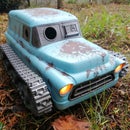Introduction: Scale Kayak for RC Crawler
A friend of mine asked me to make him some accessories for his 1:10 scale 4x4, he had downloaded a whole bunch off the internet but as usual my mind ran away with me, so I ended up designing and building him a little Kayak and paddles to go on his truck.
Tools
- 3D printer
- Hack Saw
- Sand Paper
Materials
- Filament (~25m, depending how you slice it)
- Glue (Appropriate for you filament)
- Spray Paint (Unless you like your filament colour)
Files
- Download from Thingiverse
- Download from Youmagine
Step 1: Design in CAD
You can skip this step and just download my file from one of the previous links if you don't want to modify it.
For interest's sake though, this is how I did it in Fusion 360, my CAD weapon of choice, these steps should explain exactly what is going on in the animation.
- Decide the size that you want your kayak to be (I went for 270mm, which is about 8.5 feet in 1:10 scale)
- Find some good reference pictures. Fortunately this are easy to come by on google, lots of manufacturers are kind enough to give useful top-down and side-on photos.
- Insert the reference photos and scale them approriately
- Create sketches in which you can trace all of the hard edges that are visible in both views (one sketch for the side profile of an edge and one for the top profile)
- Use the "3D intersection curve" tool to turn these two 3D views of each ridge into a curve in 3D
- Draw cross-section profiles along the length of the curves, I didn't have a "front view" in my reference photos, so I just kinda winged it.
- Use the "loft" tool to form solids between the cross-sections, using the 3D curves as guide rails.
- Draw a top view sketch of the rim around the cockpit (are there any kayakers out there who can help me with the right word here, that seems wrong?), and use the "split face" tool to cut it out.
- Use the extrusion or "press" tool to form a ridge
- Use the shell tool to make the whole thing hollow (or if Fusion 360 refuses to do this for some arcane reason, cheat like me an make a slightly smaller copy of the kayak and just cut it out with an intersection operation.
Step 2: 3D Print
There are no real tricks to printing the boat, the paddles are a little trickier.
Material
Whatever you like. I used PLA because I had it on hand, but if I did it again I would use ABS so that I didn't have to worry about it warping if left out in the sun.
ABS would also have the benefit of acetone polishing, which I think could give a really nice result.
Make sure that you have glue for whatever material you choose, I used superglue on the PLA and it worked well.
Settings
I chose to print it in two halves and glue it together, so that there was almost no support material required.
I used a layer height of 0.1mm, which resulted in a ridiculous print time of 15 hours, I would recommend a 0.2mm layer height if you are going to sand and paint it like I did.
Paddles
The paddles are designed to be printed balancing on their small ends, which can lead to some adhesion problems.
I increased bed adhesion by printing four paddle blades at the same time, positioned close enough together that the large brims overlapped and created a nice big first layer.
Step 3: Assemble Paddles
The paddles are simply lengths of M4 threaded rod, cut to size (I just went by eye) and sleeved in heatshrink. The threaded rod self-taps right into the hole in the printed part.
If you don't have threaded rod on hand, you could easily print a handle, or use a bit of dowel.
Step 4: Finishing
Surface Prep
Smooth out the print lines with sandpaper, I just used 100 and 200 grit, since I feel its ok for a white water kayak to show a few scratches.
I did not do any priming.
Paint
Black seemed far too boring for a kayak, so I sprayed it bright orange (I find it ironic that I had to try and make my print look more plasticky this time).
Since the paint was very runny and the kayak has some sharp edges, I had to paint many many many layers of fine (almost misted) paint, to avoid drip marks. I expect this will vary by paint.







![Tim's Mechanical Spider Leg [LU9685-20CU]](https://content.instructables.com/FFB/5R4I/LVKZ6G6R/FFB5R4ILVKZ6G6R.png?auto=webp&crop=1.2%3A1&frame=1&width=306)





